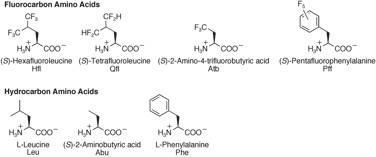
ACS PRF | ACS
All e-Annual Reports

44532-G4
The Effect of Fluorine-Containing Amino Acids on Protein Secondary Structure Stability
This project focuses on determining the alpha-helix and beta-sheet propensities for various fluoro-amino acids. The long term goal of this project is to improve the stability of enzyme catalysts for applications in organic synthesis by introducing highly fluorinated amino acids. Substituting hydrocarbon amino acids with highly fluorinated amino acids can enhance protein stability, which is known as the fluoro-stabilization effect. The secondary structure propensities for the fluoro-amino acids would be useful for quantitatively predicting the effect of fluoro-amino acids on secondary structure stability to facilitate the application of enzymes in organic synthesis.
Helix Propensity We have measured the helix propensity of the following fluoro-amino acids: (S)-5,5,5,5',5',5'-hexafluoroleucine (Hfl), (S)-5,5,5',5'-tetrafluoroleucine (Qfl), (S)-2-amino-4,4,4-trifluorobutyric acid (Atb), and (S)-pentafluorophenylalanine (Pff). The helix propensity was determined in monomeric alanine-based peptides using circular dichroism spectroscopy coupled with modified Lifson-Roig theory. Our results show that the helix propensity is consistently lower for the highly fluorinated amino acids compared to the corresponding hydrocarbon amino acids (Hfl<Qfl<Leu; Atb<Abu; Pff<Phe). Substituting Leu with Hfl decreases the helix propensity by 8-fold (1.15 kcalámol-1áresidue-1), even though this substitution can enhance the overall stability of helical proteins by 0.32-0.83 kcalámol-1áresidue-1, suggesting that the fluoro-stabilization effect more than overcomes the less favorable helix propensity of Hfl. The fluoro-stabilization effect has been attributed to hydrophobics, because the difference in hydrophobicity between Leu and Hfl (0.4 kcalámol-1áresidue-1) is similar to the change in overall helical protein stability upon substituting Leu with Hfl (0.32-0.83 kcalámol-1áresidue-1). This estimation of the fluoro-stabilization effect assumes that the helix propensities are the same for the two amino acids. However, our results show that Hfl is significantly less favorable than Leu for helix formation. Therefore, the fluoro-stabilization effect is larger than the previous estimation of 0.32-0.83 kcalámol-1áresidue-1 by 1.15 kcalámol-1áresidue-1 for Hfl. This would imply that the fluoro-stabilization effect may be more than just hydrophobics, but may also include more specific interactions such as those involving the dipole moments of the trifluoromethyl groups. Furthermore, fluoro-amino acids such as Hfl may be more suitable in non-helical structures (i.e. beta-sheet) to realize the full potential of the fluoro-stabilization effect. Sheet Propensity We have measured the beta-sheet propensity for various fluoro-amino acids (Hfl, Qfl, and Pff) in the protein G B1 domain I6A T44A double mutant. Thermal denaturation of the proteins was monitored by circular dichroism spectroscopy. The data was analyzed to obtain the relative beta-sheet propensity for the amino acids. These results show a higher beta-sheet propensity for fluoro-amino acids compared the corresponding hydrocarbon amino acid (Hfl>Qfl>Leu; Pff>Phe). Variation in beta-sheet formation energetics for amino acids have been attributed to hydrophobics, sterics, or both. Based on our results, sterics appears to play a more predominant role compared to hydrophobics in determining beta-sheet propensity. Overall, these results suggest that fluoro-amino acids should be very well suited for stabilizing beta-sheet proteins. Future Aspects Helical propensities determined from the alanine-based peptides are approximately twice of those determined from coiled coils and other proteins. Although the trends are similar, this discrepancy has raised questions regarding the generality of our results from alanine-based peptides. Therefore, we are now measuring the helix propensity of fluoro-amino acids in coiled coils. 